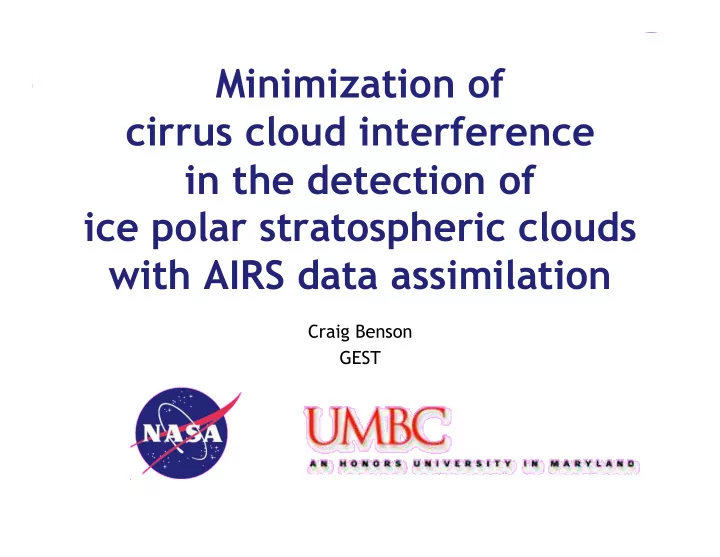

Minimization of cirrus cloud interference in the detection of ice polar stratospheric clouds with AIRS data assimilation Craig Benson GEST
Overview Hypothesis: AIRS observed-forecast (O-F) residuals can be used to detect ice polar stratospheric clouds. • Motivation • GEOS-5 overview • PSC detection theory • Model support (MODTRAN) • Observational support (CALIPSO/MLS) • Applications
Polar stratospheric clouds • PSCs form in the very cold temperatures of the Antarctic winter stratosphere despite relative dryness • Composed of STS, NAT , or water ice • PSCs play a critical role in the catalytic cycle leading to ozone loss: O 3 O 2 HNO 3 h ν + HCl Cl 2 CFCl 3 Cl ClO ClONO 2 PSC CFCl 2 NO 2 N 2 O 5 h ν + H 2 O O 2 O 2 + O h ν 2 HNO 3 2 Cl O 3
GEOS-5: 3D-Var analyses using IAU • Gridpoint Statistical Interpolation (GSI) analysis scheme, developed by NCEP and adapted by GMAO • Data: conventional (e.g.,sondes, aircraft); IR and microwave radiances from NOAA platforms and EOS-Aqua; SBUV ozone retrievals • Gridpoint GCM developed in GMAO, with “finite volume” dynamical core (Lin) and GSFC physics package (Suarez, Bacmeister) — Radiation code from Chou and Suarez — GWD from Garcia and Boville • Assimilated analyses produced using “Incremental Analysis Update” technique, via “forcing terms” in the GCM
GEOS-5 assimilation of AIRS AIRS data is thinned from a 15-km footprint to a 180- km box according to three criteria: • Measurement closest to center of box • Measurement closest to analysis time • Highest-temperature measurement Thinned AIRS data is assimilated into the GEOS-5 forecast, which is compared to thinned or unthinned AIRS measurements to generate observed-forecast residuals.
AIRS observed-forecast residuals T (K) Thinned AIRS channel 1674 (1472 cm -1 ) O-F residuals, 6-hr timeframe
PSC sensitivity Cold PSC Tropopause
MODTRAN The MODerate spectral resolution atmospheric TRANsmission code was developed by AFRL/VSBT in collaboration with Spectral Sciences, Inc. Models atmospheric propagation of electromagnetic radiation from the far-infrared (100 cm -1 ) to the deep ultraviolet (50000 cm -1 ) with a spectral resolution of 1 cm -1 . Capabilities include molecular band model parameterization, spherical refractive geometry, solar and lunar source functions, scattering (Rayleigh, Mie, single and multiple), and default profiles (gases, aerosols, clouds, fogs, and rain). Atmospheric profiles can be user-defined, including wavelength- dependent aerosol extinctions for cloud layers. Representative PSC aerosol extinctions are obtained from the IMPACT microphysics code.
MODTRAN spectrum H 2 O CO 2 • CO 2 and H 2 O bands assimilated into GEOS-5 • Most channels show sensitivity to cirrus and PSCs • Response to clouds vary with frequency
MODTRAN results 1492 cm -1 698.27 cm -1 700.22 cm -1 668.53 cm -1
CALIPSO track, 24 July 2006 O-F residuals for each of three CO 2 channels show response to PSCs as detected by CALIPSO Comparison of a large volume of CALIPSO measurements to AIRS residuals allow thresholds to be established for PSC detection Using all three channels, detection of ~40% of PSCs is possible with no false positives
Advantages of technique AIRS data colored by channel 74 O-F residual showing detected PSCs Advantages of O-F detection technique over CALIPSO include coverage; CALIPSO can miss the size of certain large PSCs and miss some small PSCs entirely CALIPSO has better sensitivity, vertical resolution
MLS water vapor depression • Ice PSC inferred by MLS water vapor measurements at 480 K on 25 Jan 2005 1 1 Jimenez et al. GRL, 33, L16806, doi:10.1029/2006GL025926, 2006.
NH ice cloud 24 January 2005 06z 24 January 2005 12z 24 January 2005 18z 25 January 2005 00z 25 January 2005 06z 25 January 2005 12z
MLS comparison H 2 O 25 January 2005 00z AIRS O-F-detected PSC corresponds HNO 3 to local depression in water vapor, as well as extended depression in nitric acid Larger cloud system is not discernible to current technique
Interannual differences • Full AIRS database can be used to generate time series of PSC formation • Fewest peak PSCs in winter of 2009, but season was long • Most PSCs in winter of 2008, with short season
PSC climatology Normalized regions of peak PSCs from 2003-2009 Dominated by base of Antarctic Peninsula; combination of low temperatures close to pole and cloud induction due to gravity waves Local maximum at 15 o E
Conclusions • Possible to detect high optical depth ice PSCs with AIRS O-F residuals • Tuning of detection parameters can minimize interference from cirrus clouds • Despite low sensitivity, technique is useful for generating climatologies, following individual clouds, or determining cloud size, and can enhance our understanding of PSC dynamics Acknowledgements Thanks to S. Pawson, I. Stajner, N. McKee, H.-C. Liu, S. Hannon, L. Strow, M. Pitts, and R. Spang
Recommend
More recommend